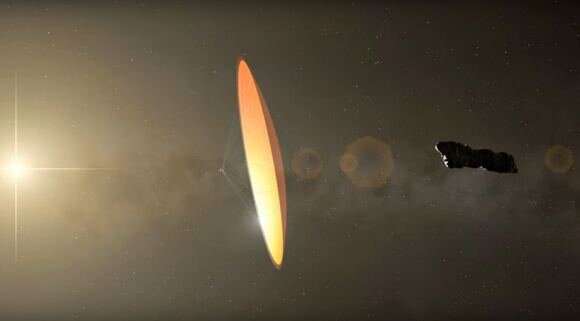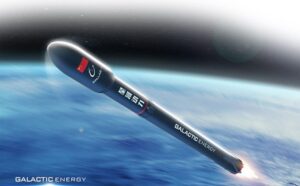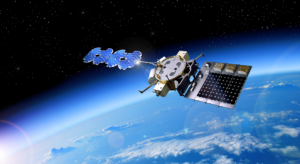If launched by 2028, a spacecraft could catch up with 'Oumuamua in 26 years
Monday, 24 January 2022 10:48
In October 2017, the interstellar object 'Oumuamua passed through our solar system, leaving many questions in its wake. Not only was it the first object of its kind ever observed, but the limited data astronomers obtained as it shot out of our solar system left them all scratching their heads. Even today, almost five years after this interstellar visitor made its flyby, scientists are still uncertain about its true nature and origins. In the end, the only way to get real answers from 'Oumuamua is to catch up with it.
Interestingly enough, there are many proposals on the table for missions that could do just that. Consider Project Lyra, a proposal by the Institute for Interstellar Studies (i4is), which would rely on advanced propulsions technology to rendezvous with interstellar objects (ISOs) and study them.
China’s Galactic Energy raises $200 million for reusable launch vehicle development
Monday, 24 January 2022 09:23
Chinese commercial rocket maker Galactic Energy raised $200 million in two funding rounds during the second half of 2021, the company announced Monday.
Fitness in 360° | Cosmic Kiss
Monday, 24 January 2022 08:00 Video:
00:01:36
Video:
00:01:36
You’ve heard of spacewalking astronauts but how do astronauts run? Join ESA’s Matthias Maurer for a workout on the International Space Station’s T2 treadmill and explore Node 3 in 360°.
Astronauts living and working on the International Space Station exercise for around two hours a day six days a week to stay fit and healthy in orbit. This helps counteract muscle and bone loss caused by life in microgravity.
The T2 treadmill is attached to the wall in Node 3 and astronauts secure themselves using a harness and bungies. This creates a feeling like running on a treadmill on
On National Security | Solar power from space: Will it ever get off the ground?
Sunday, 23 January 2022 10:00
Space-based solar power is an idea that has been studied for decades. But even though the United States was a pioneer in this technology, government interest in taking it from the lab to orbit has been tepid at best.
Worldwide coordinated search for dark matter
Saturday, 22 January 2022 11:20 An international team of researchers with key participation from the PRISMA+ Cluster of Excellence at Johannes Gutenberg University Mainz (JGU) and the Helmholtz Institute Mainz (HIM) has published for the first time comprehensive data on the search for dark matter using a worldwide network of optical magnetometers. According to the scientists, dark matter fields should produce a characteristic
An international team of researchers with key participation from the PRISMA+ Cluster of Excellence at Johannes Gutenberg University Mainz (JGU) and the Helmholtz Institute Mainz (HIM) has published for the first time comprehensive data on the search for dark matter using a worldwide network of optical magnetometers. According to the scientists, dark matter fields should produce a characteristic There are 40 billion billions of Black Holes in the Universe!
Saturday, 22 January 2022 11:20 With a new computational approach, SISSA researchers have been able to make the fascinating calculation. Moreover, according to their work, around 1% of the overall ordinary (baryonic) matter is locked up in stellar mass black holes. Their results have just been published in the prestigious 'The Astrophysical Journal'.
How many black holes are out there in the Universe? This is one of the
With a new computational approach, SISSA researchers have been able to make the fascinating calculation. Moreover, according to their work, around 1% of the overall ordinary (baryonic) matter is locked up in stellar mass black holes. Their results have just been published in the prestigious 'The Astrophysical Journal'.
How many black holes are out there in the Universe? This is one of the Scientists are a step closer to finding planets like Earth
Saturday, 22 January 2022 11:20 The UK Space Agency has invested 25 million pounds in innovative science for the European Space Agency mission, called Planetary Transits and Oscillations of stars (PLATO), ensuring UK scientists and engineers, led by the University of Warwick, will take part in all aspects of the mission.
Caroline Harper, Head of Space Science at the UK Space Agency, said:
The critical milestone rev
The UK Space Agency has invested 25 million pounds in innovative science for the European Space Agency mission, called Planetary Transits and Oscillations of stars (PLATO), ensuring UK scientists and engineers, led by the University of Warwick, will take part in all aspects of the mission.
Caroline Harper, Head of Space Science at the UK Space Agency, said:
The critical milestone rev PLATO clears decisive hurdle
Saturday, 22 January 2022 11:20 The European Space Agency (ESA) has given the green light to build the flight models of the spacecraft and science payload for the PLATO mission to search for extrasolar planets. The Critical Milestone Review officially concluded on 11 January 2022. This means that the production of the hardware for the space telescope system can now commence. The German Aerospace Center (Deutsches Zentrum fur L
The European Space Agency (ESA) has given the green light to build the flight models of the spacecraft and science payload for the PLATO mission to search for extrasolar planets. The Critical Milestone Review officially concluded on 11 January 2022. This means that the production of the hardware for the space telescope system can now commence. The German Aerospace Center (Deutsches Zentrum fur L Quantum computing in silicon hits 99% accuracy
Saturday, 22 January 2022 11:20Semiconductor spin qubits gain further credibility as leading platform for quantum computing
Saturday, 22 January 2022 11:20 Researchers at QuTech-a collaboration between the Delft University of Technology and TNO-have taken an important step for semiconductor spin qubits by surpassing the 99% barrier for two-qubit gate fidelity. They report on their findings in Nature on 19 January 2021 and are featured on the issue's cover. Two independent works from groups at UNSW Sydney and at RIKEN report similar results in the s
Researchers at QuTech-a collaboration between the Delft University of Technology and TNO-have taken an important step for semiconductor spin qubits by surpassing the 99% barrier for two-qubit gate fidelity. They report on their findings in Nature on 19 January 2021 and are featured on the issue's cover. Two independent works from groups at UNSW Sydney and at RIKEN report similar results in the s Scientists achieve key elements for fault-tolerant quantum computation in silicon spin qubits
Saturday, 22 January 2022 11:20 Researchers from RIKEN and QuTech-a collaboration between TU Delft and the Netherlands Organisation for Applied Scientific Research (TNO)- have achieved a key milestone toward the development of a fault-tolerant quantum computer.
They were able to demonstrate a two-qubit gate fidelity of 99.5 percent-higher than the 99 percent considered to be the threshold for building fault-tolerant comp
Researchers from RIKEN and QuTech-a collaboration between TU Delft and the Netherlands Organisation for Applied Scientific Research (TNO)- have achieved a key milestone toward the development of a fault-tolerant quantum computer.
They were able to demonstrate a two-qubit gate fidelity of 99.5 percent-higher than the 99 percent considered to be the threshold for building fault-tolerant comp China's new generation carrier rocket Long March-8 ready for launch
Saturday, 22 January 2022 07:53 China plans to launch its new generation carrier rocket Long March-8 Y2 between late February and early March from the southern island of Hainan, sources with the China Academy of Launch Vehicle Technology, the country's leading rocket maker, said on Friday.
The rocket arrived at the Wenchang Space Launch Center Friday after a week of ocean transport. It will undergo final assembly and tes
China plans to launch its new generation carrier rocket Long March-8 Y2 between late February and early March from the southern island of Hainan, sources with the China Academy of Launch Vehicle Technology, the country's leading rocket maker, said on Friday.
The rocket arrived at the Wenchang Space Launch Center Friday after a week of ocean transport. It will undergo final assembly and tes STEM student experiments win Flight Opportunity in NASA Tech Contest
Saturday, 22 January 2022 07:53 NASA selected 57 winning teams in an inaugural nationwide challenge designed to attract, engage, and prepare future science, technology, engineering, and mathematics professionals. The winning teams of the NASA TechRise Student Challenge will gain real world STEM experience by building experiments that autonomously operate and collect data from the edge of space aboard a suborbital rocket or a h
NASA selected 57 winning teams in an inaugural nationwide challenge designed to attract, engage, and prepare future science, technology, engineering, and mathematics professionals. The winning teams of the NASA TechRise Student Challenge will gain real world STEM experience by building experiments that autonomously operate and collect data from the edge of space aboard a suborbital rocket or a h Ejecting Mars' Pebbles
Saturday, 22 January 2022 07:53 The team has made good progress implementing the initial recovery steps outlined in last week's blog. Our first success: The upper two pebbles were ejected from the bit carousel during a test. This is great news, as these small chunks of debris are believed to be the cause of the unsuccessful transfer of the drill bit and sample tube into the carousel back on Dec. 29. Our second success: We appe
The team has made good progress implementing the initial recovery steps outlined in last week's blog. Our first success: The upper two pebbles were ejected from the bit carousel during a test. This is great news, as these small chunks of debris are believed to be the cause of the unsuccessful transfer of the drill bit and sample tube into the carousel back on Dec. 29. Our second success: We appe Consistent asteroid showers rock previous thinking on Mars craters
Saturday, 22 January 2022 07:53 New Curtin University research has confirmed the frequency of asteroid collisions that formed impact craters on Mars has been consistent over the past 600 million years.
The study, published in Earth and Planetary Science Letters, analysed the formation of more than 500 large Martian craters using a crater detection algorithm previously developed at Curtin, which automatically counts the v
New Curtin University research has confirmed the frequency of asteroid collisions that formed impact craters on Mars has been consistent over the past 600 million years.
The study, published in Earth and Planetary Science Letters, analysed the formation of more than 500 large Martian craters using a crater detection algorithm previously developed at Curtin, which automatically counts the v 
